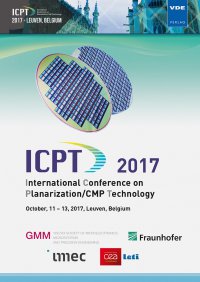Post-CMP Cleaners for Tungsten Advanced Nodes: 10 nm and 7 nm
Konferenz: ICPT 2017 - International Conference on Planarization/CMP Technology
11.10.2017 - 13.10.2017 in Leuven, Belgium
Tagungsband: ICPT 2017
Seiten: 6Sprache: EnglischTyp: PDF
Persönliche VDE-Mitglieder erhalten auf diesen Artikel 10% Rabatt
Autoren:
Lieten, Ruben R. (Entegris, Gmbh, Hugo-Junkers-Ring 5, Gebäude 107/W, 01109 Dresden, Germany)
White, Daniela; Parson, Thomas; Frye, Don; White, Michael (Entegris, Inc, 7 Commerce Drive, Danbury CT 06810, US)
Jenq, Shining (Entegris, Inc, 1F, No. 669, Section 4, Chung-Hsin Road, Chutung Town, 31061, Taiwan)
Teugels, Lieve; Struyf, Herbert (imec, Kapeldreef 75, 3001 Leuven, Belgium)
Inhalt:
W is the material for choice for filling narrow contact holes. After the W chemical vapor deposition filling process, chemical-mechanical polishing is applied for planarization. Polishing slurries used in these processes are usually aqueous, low or high pH nanodispersions containing abrasive particles (silica, alumina) and a variety of organic additives, such as ligands or complexants for the metals, oxidizers and surfactants. The main surface contaminants on the post-CMP planarized surfaces are: abrasive particles, organic residue, pad debris and metal cations. Removing these contaminants while preserving the materials in the metallization stack, requires specially designed formulations. We will discuss several mechanistic approaches and experimental data for improving post-CMP cleaning of tungsten plugs with TiN as barrier liner, W/TiN and dielectric substrates SiO2 and Si3N4. In-depth characterization of the pre- and post-CMP cleaned surfaces, as well as the metals compatibility and their galvanic corrosion behavior, are based on multiple analytical techniques: Tafel plots (electrochemistry), ζ potential, SEM, AFM, XRF, FTIR-ATM, contact angle, XPS, light scattering. In-depth analysis of the cleaned surfaces and particle/organic residue defectivity on post-CMP cleaned W, SiO2 and Si3N4 surfaces, improved our understanding of cleaning mechanisms on metal and dielectric surfaces, as well as further helped to reduce particulate defects and organic residue. Keywords: planarization, chemical-mechanical polishing, tungsten, N10, N7, TiN barrier


